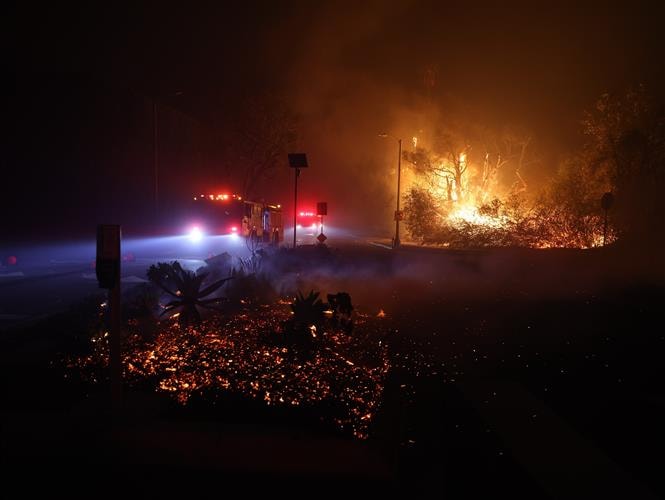As wildfires rage in residential areas, firefighters in California and elsewhere find water systems unable to keep up with demand.
.jpg)
Captain Kevin Easton and his crew spent hours battling the out-of-control blaze that was spreading through the Pacific Palisades neighborhood of Los Angeles, leaving homes in its wake. But shortly after midnight, the fire hoses ran dry.
“It’s completely dry, there’s no water to be had,” said Captain Easton, a member of a mobile patrol of firefighters trying to protect the Palisades Highlands neighborhood. As of Tuesday afternoon — hours after the fire hydrants ran dry — there was still no water. The homes in Highlands were burned to the ground, becoming part of the more than 5,000 structures destroyed by the Palisades Fire so far.
Local officials say water tanks in high-elevation areas like the Highlands and pumping systems that supply water can’t keep up with demand as fires spread from neighborhood to neighborhood. That’s partly because the designers of the systems didn’t account for the terrifying speed with which multiple fires would spread across the Los Angeles area this week.
"We're in a situation that's completely out of any water system design," said Marty Adams, former general manager and chief engineer of the Los Angeles Department of Water and Power, which is responsible for providing water to nearly four million Los Angeles residents.
City water systems are designed so firefighters can tap multiple hydrants at once, allowing them to maintain a steady flow of water to crews that may be trying to protect a large structure or a handful of homes. But these systems can collapse when wildfires, like the dry brush fires that surround Los Angeles’ hillside communities, rage through residential areas.
As urban sprawl spreads into wildland areas across the country and climate change creates conditions conducive to fires, more and more cities are facing sudden water shortages while fighting fires, most recently in Talent, Oregon; Gatlinburg, Tennessee; and Ventura County, California.
The problem can be especially acute in high-wind conditions, like what Los Angeles experienced this week, when firefighting aircraft cannot safely drop water and fire retardant in the air as they normally would.

During the 2022 Louisville, Colorado, fire crews took the bold step of dumping untreated water into the system when firefighters were running low on water supplies. In 2023, on the Hawaiian island of Maui, firefighters battling a wildfire found their hoses running dry as flames ripped through the community of Lahaina, killing 102 people in the deadliest U.S. wildfire in more than a century.
Municipal water systems like the one in Los Angeles are designed to handle high demand, including from large fires that can require multiple fire trucks to tap the system at once. But getting water to the upper reaches of hillside communities like Pacific Palisades can still be a challenge. There, water is collected in a reservoir that pumps it into three elevated tanks, each holding about a million gallons. The water then flows by gravity to homes and fire hydrants.
But the pump and storage system was designed for a fire that destroyed many homes, not a fire that destroyed hundreds of homes like the current disaster.
Ahead of this week’s dangerous weather, water tanks in Pacific Palisades and other fire-affected hillside communities were filled. But as the Palisades Fire spread on Jan. 7, the first tank there quickly ran dry. A second tank ran dry a few hours later, and a third ran dry on the morning of Jan. 8.
By the evening of January 9, Los Angeles Fire Department Chief Kristin M. Crowley said firefighters had stopped using fire hoses altogether.
Water supplies are just one of many challenges as fire crews across Los Angeles County are overwhelmed by fires burning on multiple fronts. In the Altadena area, where the Eaton Fire has burned more than 13,000 acres and up to 5,000 structures, firefighters are also dealing with water system overload.
"Those erratic winds blew the embers miles ahead of the fire and that's really what caused the fire to spread so quickly," said Chief Augustin.
Los Angeles City Council member Traci Park said the city's water system is among the most severely underfunded infrastructure.
“There are environmental disasters waiting to happen everywhere with our water mains,” said Park, adding that some water pipes are centuries old.
Greg Pierce, a researcher at the University of California, Los Angeles, who studies water resources and urban planning, agrees with concerns about water systems designed for urban fires, not fast-moving wildfires. But he says redesigning water systems so firefighters can fight large wildfires would be costly.